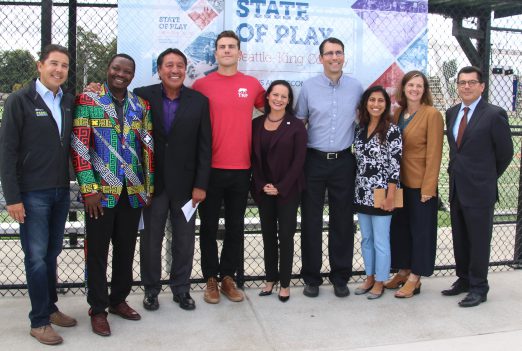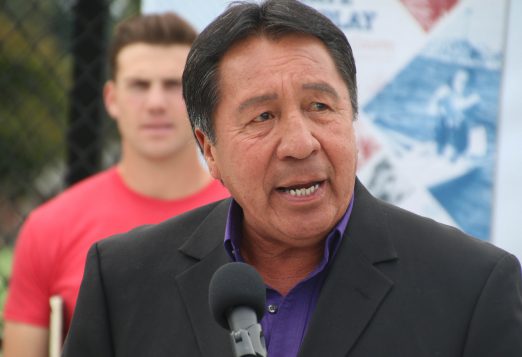GET OUT! Youth need to move more, confirms new study unveiled in White Center
A new report unveiled Tuesday in White Center is aimed at getting more activity into more youths’ lives. Our photos and video are from the event at Steve Cox Memorial Park that accompanied this King County announcement:
Too many young people in King County – particularly in communities of color – face barriers to physical activity even in a region famous for outdoor recreation, a new study conducted by the University of Washington’s Center for Leadership in Athletics in partnership with King County Parks and the Aspen Institute found. A new coalition that will include local professional sports teams and community-based organizations will implement the report’s recommendations.
A new study found that less than 19 percent of youth in King County get the amount of physical activity recommended by the Centers for Disease Control and Prevention, a figure that is below the national average and declining.
The study – conducted by the University of Washington’s Center for Leadership in Athletics in partnership with King County Parks and The Aspen Institute – recommends empowering local schools to be community hubs for physical activity and improving transportation options that connect youth to parks and playfields.
King County and the UW Center for Leadership in Athletics today launched the Play Equity Coalition – a partnership of community-based organizations, school districts, local governments, and professional sports teams, including the Mariners, Sounders, Seattle’s NHL team – will help partners implement recommendations.
“We are doing more than ever to ensure that every child and youth in our rapidly growing region enjoys the proven physical, mental, and academic benefits of exercise. It is ingrained in the work we do with land conservation, Best Starts for Kids, the renewed Parks levy, and more,” said King County Executive Dow Constantine. “The report recommendations will help us create an unprecedented alliance of local governments, schools, community organizations, and professional sports teams, uniting our efforts so more kids can play.”
Authors of the study, called State of Play: Seattle-King County, found that while screen time may play some role in declining rates of physical activity there are many other barriers keeping youth from being physically active.
A key challenge, researchers say, is that access to physical activity in King County is inequitably distributed on multiple levels, including race, language, affluence, and physical ability. Among other findings in the report, youth who do not speak English at home are both less active and less likely to participate in organized physical activity than their English-speaking peers.
“In the report, we tried to prioritize the voices of youth and families most disenfranchised from physical activity in our region. Now we have to collectively commit to taking that data seriously. It’s time for King County to recognize the vital role that physical activity plays in community health and educational outcomes and do something bold to address the inequities in who plays sports, who has recess, and who has access to outdoor play spaces,” said Julie McCleery, research associate at the UW Center for Leadership in Athletics and the report’s principal investigator.
In addition to improving physical health, exercise promotes social and emotional learning that supports whole childhood development. Research also shows that physical activity improves school attendance and academic performance.
Researchers at the UW Center for Leadership in Athletics – based in the College of Education – conducted the eight-month study, which involved more than 1,600 parents, K-12 students, and coaches through surveys, interviews, and focus groups.
The Play Equity Coalition will unite the efforts of school districts, and community partners such as Baseball Beyond Borders and Congolese Integration Network as well as Seattle Children’s Hospital and the YMCA, in addition to professional sports teams. An example action the coalition will take is to develop an equity toolkit to help programs, investments, and agencies evaluate how existing programs and policies impact access.
Removing barriers to physical activity throughout King County
While King County is famous for its outdoor recreation opportunities, many young people do not have easy access to parks, trails, and greenspace. Executive Constantine’s Land Conservation Initiative – an ambitious plan to protect 65,000 acres of the last best open spaces within a single generation – is accelerating the protection of greenspace in urban areas.
The authors of the study cited Trailhead Direct – transit-to-trails service co-led by King County Metro and King County Parks – as a successful example of improving access. The service added a new route this season that starts and ends at Sound Transit’s Tukwila International Boulevard Station and connects to all hiking trails in the Trailhead Direct network.
Other examples of King County promoting physical activity include:
The King County Parks Levy – which voters recently renewed – will provide about $110 million in grant funding for a variety of park and recreation-related programs and capital projects, which will advance many of the recommendations included in the report.
King County Park’s provides funding for youth sports through a recently expanded program that now annually provides $2.5 million for programs and capital projects through a competitive process along with $1 million in discretionary grants awarded by King County Councilmembers.
Executive Constantine’s Best Starts for Kids initiative strategically invests in health and safe environments, including $640,000 for physical activity programs.
Still, researchers say more needs to be done to overcome the barriers to physical activity that many young people face, particularly in communities of color in South King County.The study, for example, says programs should do more to provide information about activities in multiple languages. The study also recommends more innovative transportation partnerships similar to Trailhead Direct and free ORCA Opportunity cards for youth in less-affluent communities.
Researchers also recommend establishing schools as hubs for physical activity, launching a public health education campaign promoting the benefits of physical activity for youth, and providing program staff and policy-makers with an equity toolkit to help them make access to physical activity more equitable.
The research was guided by an advisory group of 27 representatives from Public Health – Seattle & King County, school districts, park agencies, nonprofits, professional sports teams, community recreation providers, and businesses.
The study was funded by the UW Center for Leadership in Athletics, King County Parks, Kaiser Permanente, Seattle Mariners, Bezos Family Foundation, YMCA of Greater Seattle, evo, and Seattle Children’s Hospital with in-kind donations from Amazon.
Among those at the announcement, local football legend Sonny Sixkiller:
And Highline Public Schools superintendent Dr. Susan Enfield:
She also declared that regarding making the study’s recommendations reality, Highline is “all in.”
You can follow any responses to this entry through the RSS 2.0 feed. Both comments and pings are currently closed.


